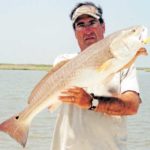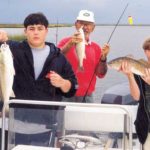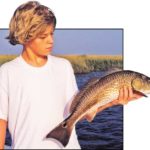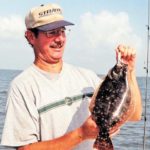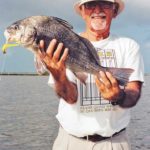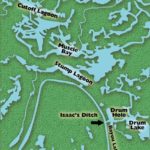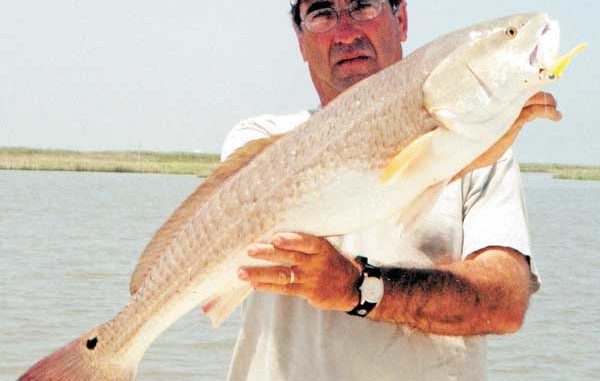
This isn’t exactly the new Hollywood craze to get in shape, but target reds in this bayou, and you’ll see how it got its name.
Bayou La Loutre, I think most will agree, is among our narrower thoroughfares for accessing honeyholes. Compared to the Barataria Seaway, the Houma Navigation Canal and what used to be the Empire and Buras canals, it’s a ditch. And compared to its neighboring Mississippi River-Gulf Outlet, it’s a mere marsh trenasse.The MRGO, as it happens, is Eddie’s traditional thoroughfare for fishing the Hopedale/Shell Beach area. This was true before his exile up north after college, and resumed when Louisiana’s voluptuous siren song (along with one divorce and two disbarments) lured him back bayou-ward.
So he was having trouble navigating Bayou La Loutre at the usual jet-fighter velocity he likes with his new boat, especially when he noticed the Katrina-downed trees along the bank and how an occasional branch poking from the water well off the bank signaled downed trees that were not clearly visible or marked.
“This is crazy!” he finally yelled, while hauling back on the gas and frowning at Pelayo. “Muscle Bayou is for winter fishing. Stump Lagoon, Muscle Bay, Muscle Bayou, this bayou itself — this is all winter fishing! We’re gonna destroy my lower unit for a buncha hardheads!”
We’d been hearing this song for three days on the phone, ever since we suggested this fishing locale for today’s trip.
“We’re not going after trout, Eddie,” Pelayo patiently explained. “And we won’t be fishing the bayou itself or Stump Lagoon or Mac’s Pass or Crooked Bayou or any of those places.
“Heck, you’ve turned into a major redfish fan since returning from your exile, right? Finally ending your obsession with feeble-fighting specks, right? Well, reds are what we’ll find in the shallow ponds on either side of Muscle Bayou, especially if we time it right.”
And this weekend seemed like perfect timing with a rare (for this area) high tide early in the morning. So we’d catch the tiny capillary-like trenasses (that still trace through this healthy marsh) emptying their cargo of redfish fodder (tiny crabs, shrimp, minnows) into the shallow ponds, and these ponds in turn emptying into Muscle Bayou.
The process concentrates the reds (and flounder and puppy drum) at these small junctures, greatly simplifying our fishing to the point of making a trolling motor superfluous. But Eddie had a crackerjack one on his new boat, and was chomping to use it.
“Yeah right!” he snorted “You guys got it all figured out, haven’t ya?”
Pelayo patted him affectionately on the back.
“Eddie, my man, have we ever steered you wrong?”
“DON’T ANSWER THAT, Eddie!” I screamed. “Pelayo didn’t mean it!”
We finally caught up with the huge shrimp boat that had been chugging eastward ahead of us, and Eddie made to pass him. But there wasn’t much room on either side, and the little space between the boat and the stump-strewn bank rose in a humongous wake.
But Eddie had been boasting almost non-stop about the fabulous qualities of his fashionable new boat — especially how the ingenious hull design enabled it to sneer at the biggest waves like he used to sneer at the biggest bouncers at 4141, Fat City, Zachary’s and The Bengal.
We’d just started smelling the shrimper’s exhaust fumes when I looked over and saw a devilish look on Eddie’s face. I remembered that look from a memorable night — more specifically, from the few seconds during that night shortly before we’d rushed Eddie to our Lady of The Lake Hospital from The Bengal.
While waiting for our tables, we’ve all peered in those ponds or aquariums at Chinese restaurants and seen those goldfish with the gigantic bulging black eyes, right?
Wouldn’t you know that Kim Carnes’ hit “Betty Davis Eyes” just happened to be topping the charts at the time of Eddie’s barroom bravura? Eddie’s concerned and supportive Tigerland chums found that by serenading their temporarily-incapacitated friend with that song (spiced-up with new lyrics), the effect much surpassed the effect from the prescribed pain-killers he was gulping like M&Ms.
At any rate, Eddie now peered ahead with those same wild eyes — and gunned it. We hadn’t been able to see past the shrimp boat, who seemed to be slowing down to allow us passage. In this narrow bayou, seeing ahead (or behind) a big shrimp trawler or oyster lugger is often difficult. And about two miles before the entrance to Stump Lagoon, Bayou La Loutre makes a sharp loop, making forward reconnaissance utterly impossible — shrimp boat or no shrimp boat.
And wouldn’t you know it? Here’s where Eddie decided to shoot the gap. I was horrified, standing with my knees bent and with a two-fisted grip on the console bar. A grimacing and wild-eyed Pelayo sat next to Eddie on the long driver’s seat.
WROOOOOOOM!
Judging the size of a wave as you head into it is fairly easy, especially with white caps. But everyone who travels the Mississippi from The Jump downward knows that judging the magnitude of a big boat wake differs altogether, especially when you’re coming up on its back side. They just seem to show up in front of you then — SLAM!!
Ice chests, tackle boxes and cherished fishing companions sprawl all over the deck. The clattering racket from the former dies just in time for the louder racket from the latter, especially from the one who repeatedly issued warnings a minute earlier and now vigorously rubs his knees, elbows and forehead while bellowing and spraying spittle all over the console.
At any rate, we were climbing the crest of this wake when a boat horn erupted with a deafening blast.
“LOOK OUT!!” both Pelayo and I yelled as we ducked.
Another boatload of fishermen, coming in the opposite direction, had decided to shoot the gap at this same time — and on the same side of the shrimp boat!
The horn blast came from the shrimper, who was the only one in position to see and judge the looming calamity. Pelayo lunged for the throttle but missed just as Eddie turned sharply and missed the oncoming boat full of yelling, waving, wide-eyed fishermen by about 2 feet and a big branch from a submerged live-oak by about 10 inches. If Pelayo had grabbed the throttle and slowed us down, the oncoming boat would have smashed us, unless it ski-jumped over us like those boats in the movie Live and Let Die. Or we ski-jumped over it.
As it was, Eddie’s new boat came down of the wake and roared off, its occupants soaked by spray but otherwise unscathed (except for our nervous systems), as did the other boat. We looked back, but the loop in the bayou blocked any view of the other boat. Apparently they were no more eager to compare notes than we were. They kept going too.
The shrimper blasted off a couple more notes, in amusement rather than alarm this time. We looked back, and some of his crew had emerged on the bow, convulsed in hysterics.
But it would take us ’til the third toddy at Doc Fontaine’s gazebo that night to fully appreciate the incident’s humor, at which time our own convulsions of cackling and drooling made coherent speech — and even breathing — problematical. The wives were in the den and oblivious, while mesmerized by an old Gino Vanelli concert on cable TV.
We finally hung a left into Stump, crossed it and wove our way back to Muscle Bay, where we decided to indulge Eddie’s lingering hang-up by stopping at the mouth of Muscle Bayou to cast for trout.
“Hey there!” Pelayo yelled on his third cast with white tandem beetles under a cork. “Fall sometimes comes early around here!”
Shortly he was swinging aboard a school speck, just as Eddie reared back on his pole and another speck hit the surface in that gill and mouth-shaking frenzy of theirs. Then the trout gave a couple of its classic feeble lunges, a little more mouth rattling and Eddie swung it aboard.
“Hey, hey!” Eddie beamed. “Just like in the old days, huh? Same kinda trout action we always had around here during the first split of duck season!”
Meanwhile, I’d noticed a boat to the north that had troll-motored inside on of the very ponds I planned on fishing. He was only a couple hundred yards away, so I rummaged the binoculars from my knapsack and started spying. As expected, they were trolling around the edges of the pond, casting what looked like spoons and plastic cocahoes with their fashionable baitcasting outfits. Cast and retrieve, cast and retrieve.
Finally one of the elegantly attired chaps raised his rod high overhead. He quickly reeled what looked like an undersized rat red, and just as quickly released it.
Meanwhile, Eddie hauled in another anemic speckled trout that barely bent his rod, much less discomfitted his reel’s drag. But Eddie beamed from ear to ear while tossing the lame creature into the box while boasting that the pathetically languid fish measured 15 inches.
“Well,” I added, “he’ll certainly FRY up nice! But what y’all say we go after fish that fry-up nice but also grill-up and courtboullion-up nice? And also strip your spool and strain your biceps after he slams your bait?”
Nobody payed any attention to me. But after another 15 minutes of furious cork-popping with only two frantically leaping ladyfish to show for the effort, they finally conceded, and I hauled in the anchor.
“Why we goin’ in here?” Eddie had also noticed the bay boat with the fashionable baitcasters, and now we passed it as it left the pond. The elegantly clad crew all gave that tell-tale nod and shrug that generally means: “Where dey at?”
“We caught a couple trout,” Pelayo shrugged while pointing behind us.
“Those guys combed this pond?” Eddie snorted from the bow, while proudly manning his fashionable new trolling motor. “What’s the point?”
“Head right for that corner,” pointed Pelayo to where a tiny trenasse emptied into the pond.
As we neared, I could make out the current line and even the mini-rip that formed from the outflow. The water exiting the trenasse was chocolate-milk muddy, whereas the pond was a cloudy root-beer. Offshore, as we all know, rips concentrate fish. The bigger predator fish use the cloudier water as lions and leopards use Africa’s tall grass.
Well, something very similar happens inshore.
“SAW THAT?” Eddie suddenly shouted from the bow.
“Sure did, Eddie my man!” I smiled.
A school of finger-mullet that had congregated at the trenasse mouth, with their own little mouths gulping at the surface, had suddenly erupted, even sending one of the little 4-inch fish flopping on the muddy bank for a few seconds. Now a big wake creased the broken, grassy shoreline.
It didn’t require a PhD in Fishingology to figure out what was afoot.
“Kill it, Eddie,” Pelayo advised, and Eddie shut off the trolling motor about 100 feet from the bank. We drifted in another 20 feet and I e-a-s-e-d the anchor over.
My cork hit the water actually inside the trenasse. It started drifting out, and I popped it twice. Suddenly a huge swirl enveloped my cork but it stayed up!
“He’s smacking your cork!” Pelayo yelled.
And I knew what was coming next — another smack, another swirl — hah! The cork disappeared. I reeled in a few cranks of slack, felt pressure and reared back with my rod high overhead. The water exploded, I whooped like a lunatic and it was off to the races.
‘Wow!” was all Eddie could manage as the wake headed past us and toward the middle of the pond. “He’s taking off like a striped ape! Like By HEK used to say!”
I reeled furiously on my unfashionable spinning reel, knowing all too well how reds take advantage of the slightest slack to throw a hook. But when I reeled in the slack, I felt that heavy, heavenly pressure again, and knew he was on for good.
“YEAH!” I howled again as I raised the rod overhead and the reel started singing.
Since my fish was in the open water now, Pelayo quickly raised his unfashionable spinning outfit, and also cast at the trenasse with a nice chunk of unfashionable shrimp on his beetle. It took him all of three pops before his cork zoomed off sideways (he had it set a little too deep — 2 feet). So he set the hook on another red that frothed the surface before rocketing off, just like mine, into the open water. The bigger ones always seem to do this.
“You can HAVE your beloved bonefish, flyfishing nerds!” Pelayo bellowed. “I’ll take this guy ANYDAY!”
And he held his unfashionable spinning reel to his ear, auditorially savoring the drag’s sweet music.
Then Eddie cast his retro rig — a shad-rig tipped with half an unfashionable chunk of shrimp from his unfashionable spinning outfit. The bait hit near the bank where the mini-rip nudged an eroded grassline, and his cork never appeared. The blaze-orange Styrofoam thing plunged the second it hit the murky water. But this redfish raced off along the shoreline, bowling over a few tufts of grass with the 12-pound mono. I awkwardly netted my own red as Eddie moved past me for a position on the bow to properly play his fish.
Our next six casts, all with unfashionably shrimp-sweetened jigs, yielded two flounder and a gorgeous puppy drum that fought as maniacally as the reds and that — despite his unfashionable chunky physique — has gorgeous white flesh that grills up as beautifully as that of his kissin’ cousin, the redfish.
Flounder hunt minnows and shrimp like most of us hunt deer. They sit around waiting for one to happen by, then they shoot out and grab it. So naturally, they stake out current-washed areas as bottlenecks, like we stake out a creek-crossing or break in a fenceline as a bottleneck for deer. This trenasse outlet, and others like it, are just the ticket for flounder.
We anchored at three more spots almost identical to the first one as we made our way up Muscle Bayou toward Bayou Biloxi, and closed out with 11 reds (seven of them over 6 pounds), two more drum, four more flounder along with those first two school specks — far from a three-man limit, but we had a trip fishermen from anywhere in the U.S. would drool over.
Identical spots are found off Crooked Bayou and Bayous Biloxi, False Mouth and Sue. Aerial photos, even from before Katrina, accurately show most of these thin capillary-like trenasses, which are easy to miss from a boat.
So we’re not talking rocket science here — just dynamite fishing.
